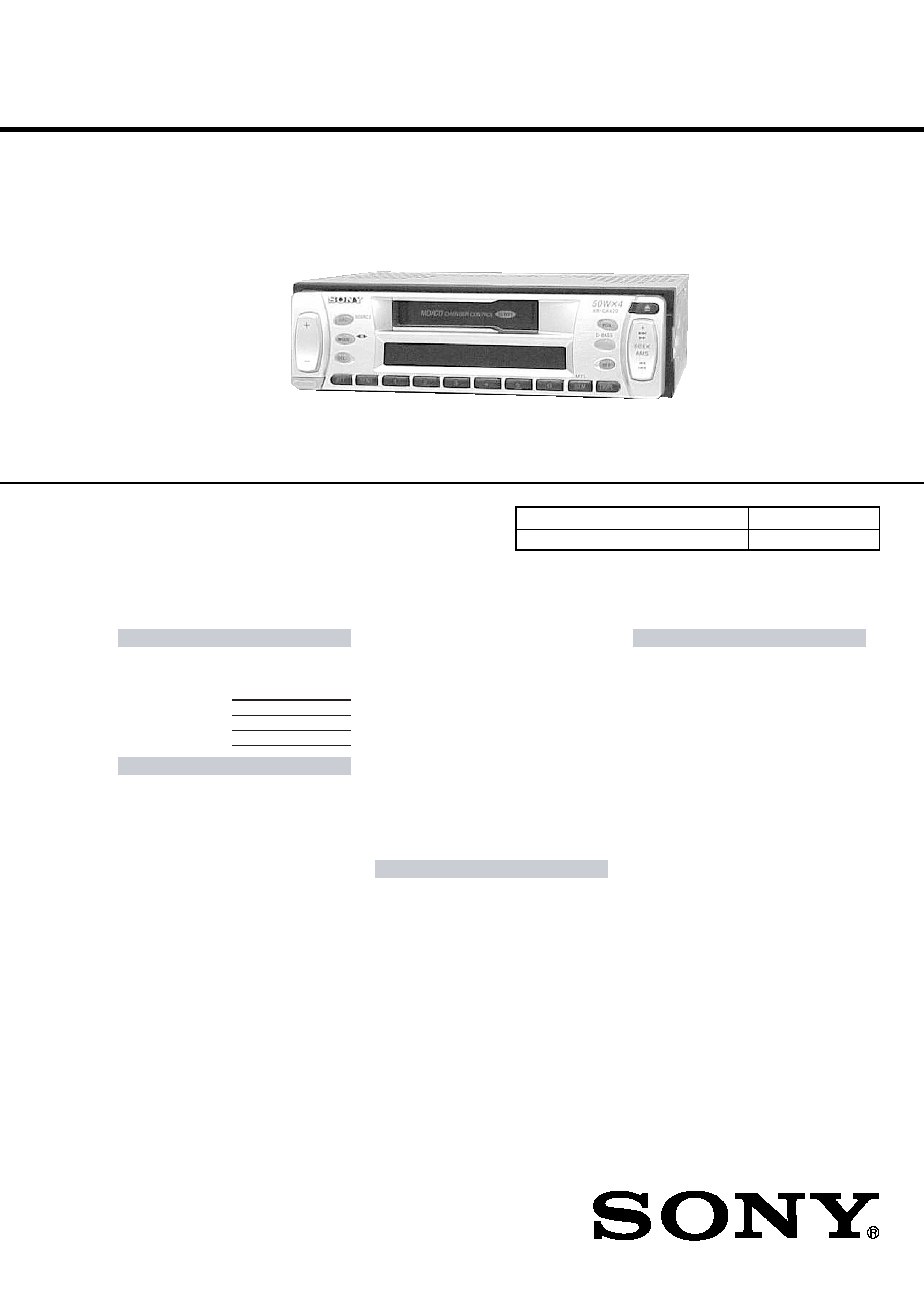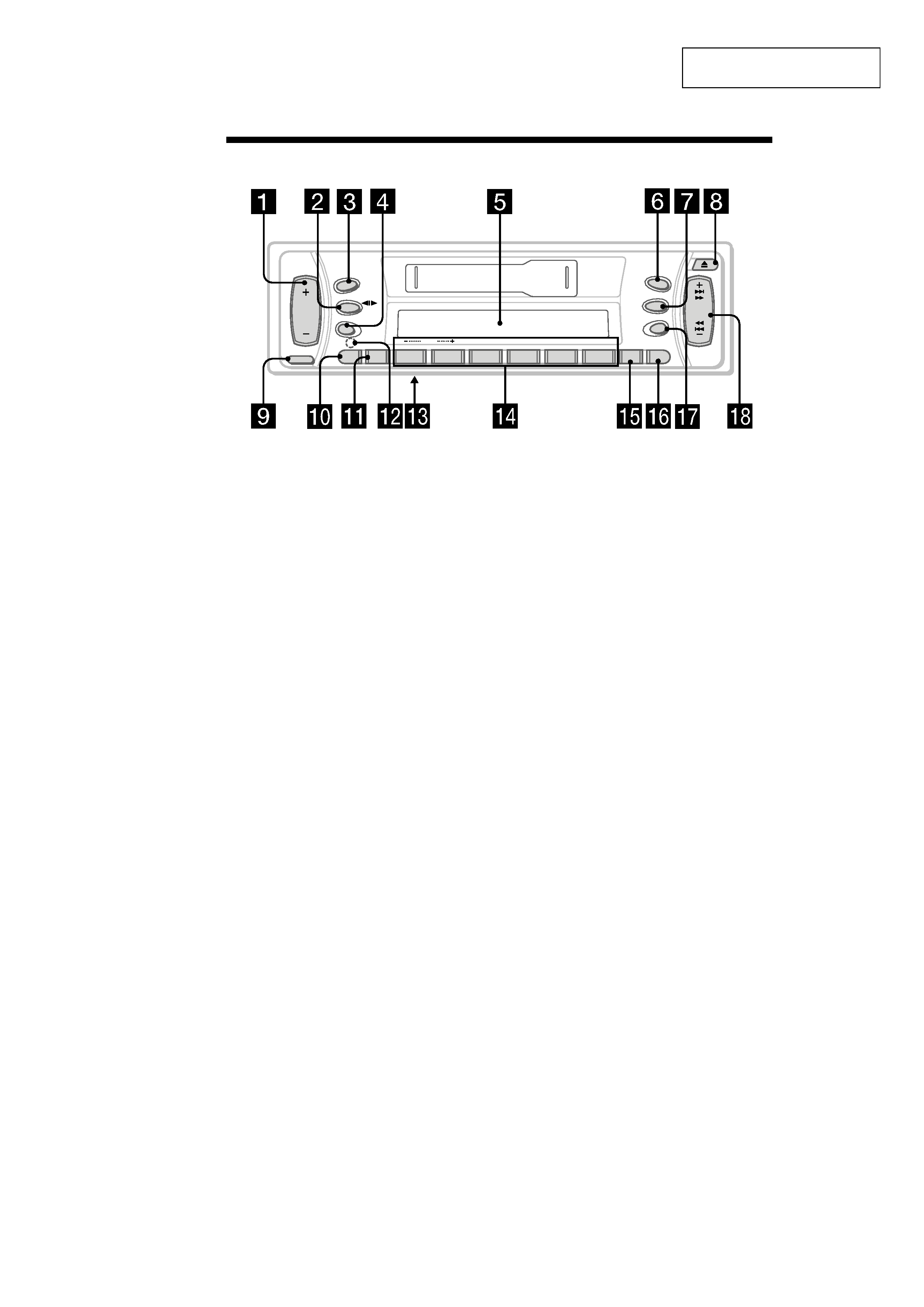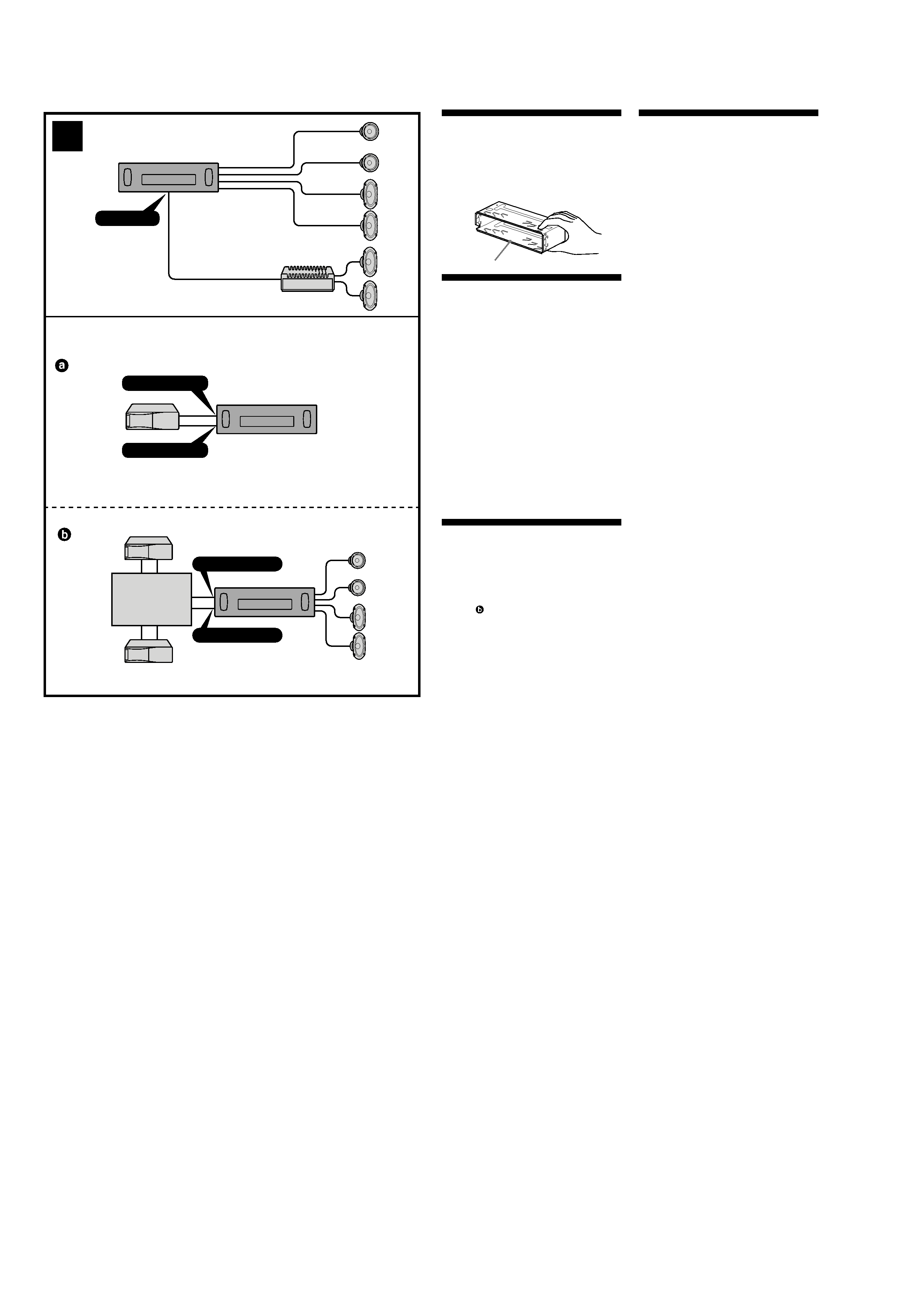
SERVICE MANUAL
FM/MW/SW CASSETTE CAR STEREO
E Model
SPECIFICATIONS
XR-CA420
Ver 1.0 2001.4
9-870-295-11
Sony Corporation
2001D0500-1
e Vehicle company
C
2000.4
Shinagawa Tec Service Manual Production Group
Model Name Using Similar Mechanism
XR-C5600X
Tape Transport Mechanism Type
MG-25F-136
Cassette player section
Tape track
4-track 2-channel stereo
Wow and flutter
0.08 % (WRMS)
Frequency response
30 18,000 Hz
Signal-to-noise ratio
Cassette type
TYPE II, IV
61 dB
TYPE I
58 dB
Tuner section
FM
Tuning range
FM tuning interval:
50 kHz/200 kHz
switchable
87.5 108.0 MHz
(at 50 kHz step)
87.5 107.9 MHz
(at 200 kHz step)
Aerial terminal
External aerial connector
Intermediate frequency
10.7 MHz
Usable sensitivity
11 dBf
Selectivity
75 dB at 400 kHz
Signal-to-noise ratio
63 dB (stereo),
68 dB (mono)
Harmonic distortion at 1 kHz
0.7 % (stereo),
0.5 % (mono)
Separation
33 dB at 1 kHz
Frequency response
30 15,000 Hz
MW
Tuning range
MW tuning interval:
9 kHz/10 kHz switchable
531 1,602 kHz
(at 9 kHz step)
530 1,710 kHz
(at 10 kHz step)
Sensitivity
30
µV
SW
Tuning range
SW tuning interval:
SW1: 2,940 7,735 kHz
SW2: 9,500 18,135 kHz
(except for 10,140 11,575
kHz)
Sensitivity
40
µV
Aerial terminal
External aerial connector
Intermediate frequency
10.7 MHz/450 kHz
Power amplifier section
Outputs
Speaker outputs
(sure seal connectors)
Speaker impedance
4 8 ohms
Maximum power output 50 W
× 4 (at 4 ohms)
General
Outputs
Audio output
Power aerial relay control
lead
Power amplifier control
lead
Tone controls
Bass
±9 dB at 100 Hz
Treble
±9 dB at 10 kHz
Power requirements
12 V DC car battery
(negative earth)
Dimensions
Approx. 178
× 50 × 178 mm
(w/h/d)
Mounting dimensions
Approx. 182
× 53 × 161 mm
(w/h/d)
Mass
Approx. 1.2 kg
Supplied accessories
Parts for installation and
connections (1 set)
Front panel case (1)
Design and specifications are subject to change
without notice.

2
XR-CA420
TABLE OF CONTENTS
1.
GENERAL
Location of Controls .......................................................
3
2.
DISASSEMBLY
2-1. Disassembly Flow ...........................................................
8
2-2. Cover ...............................................................................
8
2-3. Mechanism Deck (MG-25F-136) ...................................
9
2-4. MAIN Board ...................................................................
9
2-5. Heat Sink ......................................................................... 10
3.
ASSEMBLY OF MECHANISM DECK
3-1. Assembly Flow ................................................................ 11
3-2. Housing ........................................................................... 12
3-3. Arm (Suction) ................................................................. 12
3-4. Lever (LDG-A)/(LDG-B) ............................................... 13
3-5. Gear (LDG-FT) ............................................................... 13
3-6. Guide (C) ......................................................................... 14
3-7. Mounting Position of Capstan/Reel Motor (M901) ....... 14
4.
MECHANICAL ADJUSTMENTS ....................... 15
5.
ELECTRICAL ADJUSTMENTS
Tape Deck Section .......................................................... 15
Tuner Section .................................................................. 15
6.
DIAGRAMS
6-1. Note for Printed Wiring Boards and
Schematic Diagrams ....................................................... 16
6-2. Printed Wiring Board MAIN Board ......................... 18
6-3. Schematic Diagram MAIN Board (1/3) ................... 19
6-4. Schematic Diagram MAIN Board (2/3) ................... 20
6-5. Schematic Diagram MAIN Board (3/3) ................... 21
6-6. Printed Wiring Board KEY Board ............................ 22
6-7. Schematic Diagram KEY Board .............................. 23
6-8. IC Pin Function Description ........................................... 24
7.
EXPLODED VIEWS
7-1. Chassis Section ............................................................... 26
7-2. Front Panel Section ......................................................... 27
7-3. Mechanism Deck Section (MG-25F-136) ...................... 28
8.
ELECTRICAL PARTS LIST ............................... 29
Notes on chip component replacement
· Never reuse a disconnected chip component.
· Notice that the minus side of a tantalum capacitor may be dam-
aged by heat.
Flexible Circuit Board Repairing
· Keep the temperature of the soldering iron around 270 °C dur-
ing repairing.
· Do not touch the soldering iron on the same conductor of the
circuit board (within 3 times).
· Be careful not to apply force on the conductor when soldering
or unsoldering.

3
XR-CA420
SECTION 1
GENERAL
This section is extracted from
instruction manual.
5
Location of controls
RELEASE
SEL
MODE
SRC
OFF
D
D-BASS
MBP
6
5
4
3
2
1
BTM
DSPL
DISC
REP
SHUF
BL SKIP
ATA
MTL
ATT
SEEK
AMS
SENS
SOURCE
Refer to the pages listed for details.
1 Volume +/ button 7, 10
2 MODE (o) button
During tape playback:
Playback direction change 7, 8
During radio reception:
BAND select 9
During CD/MD playback:
CD/MD unit select 12
3 SRC (SOURCE) (TUNER/TAPE/CD/MD)
button 7, 9, 12
4 SEL (select) button 7, 10, 11, 12, 13
5 Display window
6 MBP (My Best sound Position) button
12
7 D (D-BASS) button 11
8 Z (eject) button 7
9 RELEASE (front panel release) button
6, 15
q; ATT (attenuate) button 10
qa SENS button 10
qs RESET button (located on the front side
of the unit behind the front panel) 6
qd Frequency select switch
(located on the bottom of the unit)
See "Frequency select switch" in the
Installation/Connections manual.
qf Number buttons 8, 9, 11, 13, 14
During radio reception:
Preset number select 9
During tape playback:
(3)
REP 8
(5)
BL SKIP 8
(6)
ATA 8
During CD/MD playback:
(1)
DISC 13
(2)
DISC + 13
(3)
REP 14
(4)
SHUF 14
qg BTM/MTL (Best TuningMemory/Metal)
button 8, 9
qh DSPL (display mode change) button
7, 12, 13
qj OFF button* 6, 7
qk SEEK/AMS +/ button 8, 9, 10, 13
Seek 10
Automatic Music Sensor 8, 13
Manual search 13
* Warning when installing in a car
without ACC (accessory) position on
the ignition key switch
Be sure to press (OFF) on the unit for two
seconds to turn off the clock display after
turning off the engine.
When you press (OFF) momentarily, the
clock display does not turn off and this
causes battery wear.

4
XR-CA420
Parts Iist (1)
The numbers in the list are keyed to those in the
instructions.
Caution
Handle the bracket
1 carefully to avoid injuring
your fingers.
Cautions
· This unit is designed for negative earth 12 V
DC operation only.
· Do not get the wires under a screw, or caught
in moving parts (e.g. seat railing).
· Before making connections, disconnect the
earth terminal of the car battery to avoid short
circuits.
· Connect the yellow and red power input leads
only after all other leads have been connected.
· Run all earth wires to a common earth
point.
· Be sure to insulate any loose unconnected
wires with electrical tape for safety.
Notes on the power supply cord (yellow)
· When connecting this unit in combination with
other stereo components, the connected car
circuit's rating must be higher than the sum of
each component's fuse.
· When no car circuits are rated high enough,
connect the unit directly to the battery.
Connection example (2)
Notes (2-A)
· Be sure to connect the earth cord before
connecting the amplifier.
· If you connect an optional power amplifier and do
not use the built-in amplifier, the beep sound will
be deactivated.
Tip (2-B-
)
For connecting two or more changers, the source
selector XA-C30 (optional) is necessary.
Connection diagram (3)
1 To a metal surface of the car
First connect the black earth lead, then connect
the yellow and red power input leads.
2 To the power aerial control lead or power
supply lead of aerial booster amplifier
Notes
· It is not necessary to connect this lead if there
is no power aerial or aerial booster, or with a
manually-operated telescopic aerial.
· When your car has a built-in FM/AM (MW/SW)
aerial in the rear/side glass, see "Notes on the
control and power supply leads."
3 To AMP REMOTE IN of an optional power
amplifier
This connection is only for amplifiers. Connecting
any other system may damage the unit.
4 To the +12 V power terminal which is energised
in the accessory position of the ignition key
switch
Notes
· If there is no accessory position, connect to the
+12 V power (battery) terminal which is
energised at all times.
Be sure to connect the black earth lead to it
first.
· When your car has a built-in FM/AM (MW/SW)
aerial in the rear/side glass, see "Notes on the
control and power supply leads."
5 To the +12 V power terminal which is energised
at all times
Be sure to connect the black earth lead to it first.
Notes on the control and power supply leads
· The power aerial control lead (blue) supplies +12 V
DC when you turn on the tuner.
· When your car has built-in FM/AM (MW/SW) aerial
in the rear/side glass, connect the power aerial
control lead (blue) or the accessory power input
lead (red) to the power terminal of the existing
aerial booster. For details, consult your dealer.
· A power aerial without relay box cannot be used
with this unit.
Memory hold connection
When the yellow power input lead is connected,
power will always be supplied to the memory circuit
even when the ignition key is turned off.
Notes on speaker connection
· Before connecting the speakers, turn the unit off.
· Use speakers with an impedance of 4 to 8 ohms,
and with adequate power handling capacities to
avoid its damage.
· Do not connect the speaker terminals to the car
chassis, or connect the terminals of the right
speakers with those of the left speaker.
· Do not connect the earth lead of this unit to the
negative () terminal of the speaker.
· Do not attempt to connect the speakers in parallel.
· Connect only passive speakers. Connecting active
speakers (with built-in amplifiers) to the speaker
terminals may damage the unit.
1
2
B
A
BUS AUDIO IN
BUS CONTROL IN
AUDIO OUT
Source selector
Selector de fuente
BUS CONTROL IN
BUS AUDIO IN

5
XR-CA420
BUS
AUDIO IN
AUDIO
OUT
Lista de componentes (1)
Los números de la lista corresponden a los de las
instrucciones.
Precaución
Tenga mucho cuidado al manipular el soporte
1
para evitar posibles lesiones en los dedos.
Precauciones
· Esta unidad ha sido diseñada para alimentarse
con 12 V CC, negativo a masa, solamente.
· No coloque los cables debajo de ningún tornillo,
ni los aprisione con partes móviles (p.ej. los raíles
del asiento).
· Antes de realizar las conexiones, desconecte el
terminal de puesta a masa de la batería del
automóvil a fin de evitar cortocircuitos.
· Conecte los cables de entrada de alimentación
amarillo y rojo solamente después de haber
conectado los demás.
· Conecte todos los conductores de puesta a
masa a un punto común.
· Por razones de seguridad, asegúrese de aislar con
cinta eléctrica los cables sueltos que no estén
conectados.
Notas sobre el cable de suministro de
alimentación (amarillo)
· Cuando conecte esta unidad en combinación con
otros componentes estéreo, la capacidad nominal
del circuito conectado del automóvil debe ser
superior a la suma del fusible de cada
componente.
· Si no hay circuitos del automóvil con capacidad
nominal suficientemente alta, conecte la unidad
directamente a la batería.
Ejemplo de conexiones (2)
Notas (2-A)
· Asegúrese de conectar primero el cable de puesta
a masa antes de realizar la conexión al
amplificador.
· Si conecta un amplificador de potencia opcional y
no utiliza el incorporado, los pitidos se
desactivarán.
Consejo (2-B-
)
Cuando desee conectar dos o más cambiadores,
necesitará un selector de fuente XA-C30 (opcional).
Diagramas de conexión (3)
1 A una superficie metálica del automóvil
Conecte primero el cable de masa negro, y después
los cables amarillo y rojo de entrada de
alimentación.para obtener información detallada.
2 Al cable de control de la antena motorizada o al
cable de fuente de alimentación del amplificador de
antena
Notas
· Si no se dispone de antena motorizada ni de
amplificador de antena, o se utiliza una antena
telescópica accionada manualmente, no será
necesario conectar este cable.
· Si el automóvil incorpora una antena de
FM/AM
(MW/SW) en el cristal trasero/lateral, consulte
"Notas sobre los cables de control y de fuente de
alimentación".
3 Para conectar a AMP REMOTE IN del amplificador de
potencia opcional
Esta conexión es sólo para amplificadores.
La conexión de cualquier otra sistema puede dañar
la unidad.
4 Al terminal de alimentación de +12 V que recibe
energía en la posición de accesorios del interruptor
de la llave de encendido
Notas
· Si no hay posición de accesorios, conéctelo al
terminal de alimentación (batería) de +12 V que
recibe energía sin interrupción.
Asegúrese de conectar primero el cable de masa
negro.
· Si el automóvil incorpora una antena de
FM/AM
(MW/SW) en el cristal trasero/lateral, consulte
"Notas sobre los cables de control y de fuente de
alimentación".
5 Al terminal de alimentación de +12 V que recibe
energía sin interrupción
Asegúrese de conectar primero el cable de masa
negro.
Notas sobre los cables de control y de fuente de
alimentación
· El conductor de control de la antena motorizada (azul)
suministrará +12 V CC cuando conecte la alimentación
del sintonizador.
· Si el automóvil dispone de una antena de
FM/AM
(MW/SW) incorporada en el cristal trasero/lateral,
conecte el cable de control de antena motorizada
(azul) o el cable de entrada de alimentación auxiliar
(rojo) al terminal de alimentación del amplificador de
antena existente. Para obtener información detallada,
consulte a su proveedor.
· Con esta unidad no es posible utilizar una antena
motorizada sin caja de relé.
Conexión para protección de la memoria
Si conecta el conductor de entrada amarillo, el circuito
de la memoria recibirá siempre alimentación, incluso
aunque ponga la llave de encendido en la posición OFF.
Notas sobre la conexión de los altavoces
· Antes de conectar los altavoces, desconecte la
alimentación de la unidad.
· Utilice altavoces con una impedancia de 4 a 8 ohmios
con la capacidad de potencia adecuada para evitar que
se dañen.
· No conecte los terminales de altavoz al chasis del
automóvil, ni conecte los terminales del altavoz
derecho con los del izquierdo.
·
No conecte el cable de puesta a tierra de esta
unidad al terminal negativo () del altavoz.
· No intente conectar los altavoces en paralelo.
· Conecte solamente altavoces pasivos. Si conecta
altavoces activos (con amplificadores incorporados) a
los terminales de altavoz, puede dañar la unidad.
3
Supplied with XA-C30
Suministrado con el XA-C30
from car aerial adaptor
del adaptador de antena de
automóvil
Source selector
Selector de fuente
1
4
5
2
AMP REM
ANT REM
7
RCA pin cord (not supplied)
Cable con clavijas RCA (no suministrado)
Max. supply current 0.3 A
Corriente máx. de alimentación de 0,3 A
Max. supply current 0.1 A
Corriente máx. de alimentación de 0,1 A
Fuse (10 A)
Fusible (10 A)
Red
Rojo
Yellow
Amarillo
Black
Negro
Blue
Azul
Blue/white striped
Con raya azul/blanca
White
Blanco
Green
Verde
Purple
Púrpura
White/black striped
Con raya blanco/negro
Grey/black striped
Con raya gris/negro
Green/black striped
Con raya verde/negro
Purple/black striped
Con raya púrpura/negro
BUS CONTROL IN
AUDIO OUT
Grey
Gris
1
1
·
·
·
·
·
·
·
·
2
2
·
·
2
3
1
2
·
·
3
4
·
·
5
·
·
·
·
·
·
·
·
·
Supplied with the CD/MD changer
Suministrado con el cambiador de CD/MD
3
Left
Izquierdo
Right
Derecho
Left
Izquierdo
Right
Derecho
XR-CA420X
XR-CA420
1
1
BUS AUDIO IN
